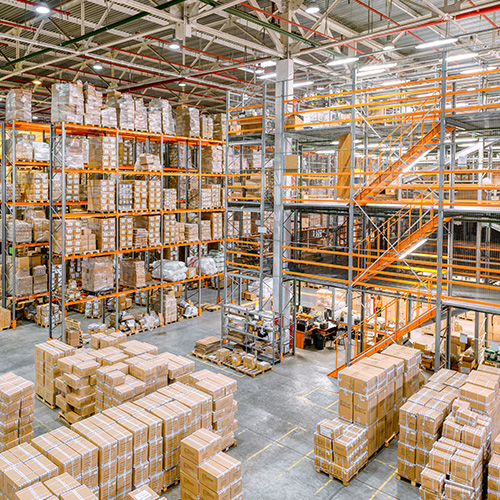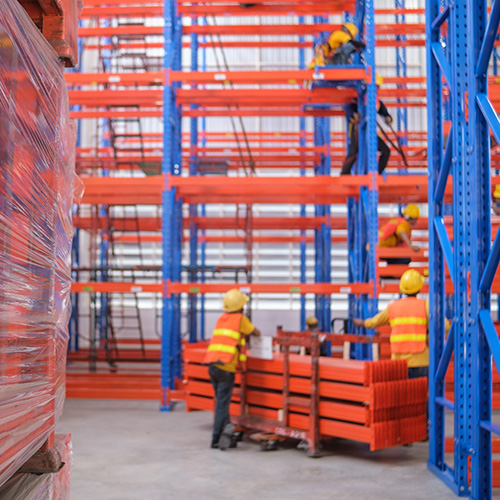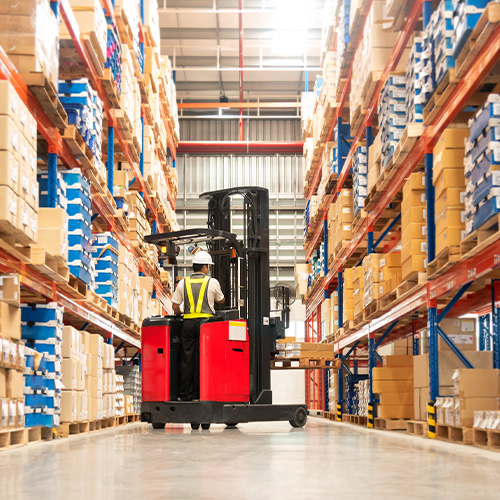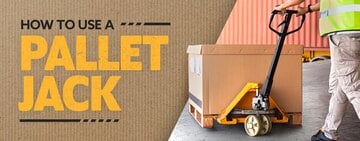
If you operate a warehouse, you’ll know that implementing a strong organization method is imperative for running a successful business. A pallet racking system is a great way to help with just that by organizing stock, carrying out orders succesfully, and maximizing space in your warehouse setup.
Shop All Pallet RacksWhat Is Pallet Racking?
Pallet racking is a storage system method that organizes palletized materials. The racks are set up horizontally and on multiple levels to utilize vertical space in buildings such as warehouses. Additionally, they are organized in such a way that forklifts and other material handling equipment can easily access the racks.
Types of Pallet Racking

There are many different types of pallet racking systems to integrate into the flow of your warehouse. Below are a few you can use:
1. Selective Pallet Racking
Selective pallet racking is the most common type of pallet racking. It is versatile and can hold a wide range of products varying in size and weight. This pallet racking system is a single deep design, so there is high accessibility to every pallet.
Selective Pallet Racking Benefits
- Low install cost
- Does not need special equipment such as forklifts
- Perfect for a variety of product sizes
- Stock is easily accessible
Selective Pallet Racking Drawbacks
- Does not hold as much storage as other pallet racking systems
2. Cantilever Racking
Cantilever racking is a type of pallet racking that’s especially strong, heavy-duty, and made for storing long and/or bulky items. These materials include steel piping, lumber, and plasterboard which is great for furniture, motorcycles, and boats.
Cantilever Racking Benefits
- Low install cost
- Stores oversized and oddly-shaped products
Cantilever Racking Drawbacks
- Requires the use of forklifts
- Needs wide aisles to accommodate forklifts
3. Drive-In Pallet Racking
Drive-in pallet racking is ideal for inventory with similar-sized dimensions that shift regularly. This system is configured so the forklift truck can operate within the rack and does not require separate lanes between rows as selective pallet racking requires. This configuration also allows for high-density storage and denser arrangement of products, so the same amount of storage can be had in a tighter arrangement, saving valuable space in your warehouse.
Drive-In Pallet Racking Benefits
- Able to store a good amount of product
- Ideal for warehouses that utilize Last In/First Out (LIFO)
Drive-In Pallet Racking Drawbacks
- Cannot accommodate a wide variety of pallet sizes
- Increased risk of impact between forklift and racking
4. Push-Back Pallet Racking
Push-back pallet racking is ideal for warehouses that use the LIFO system. The configuration has pallets loaded on trays that are being pushed along the rails of the rack frame, and the other pallets push back when a new pallet is loaded and pushed along the rails. In other words, the pallet is loaded at the front of the line and picked up from the front of the line. Push-back pallet racking can store a large number of varying-sized pallets that are easily accessible.
Push-Back Pallet Racking Benefits
- Able to store a good amount of product
- Ideal for warehouses that utilize LIFO
Push-Back Pallet Racking Drawbacks
- Costly storage option
5. Pallet Flow Pallet Racking
Pallet flow pallet racking is similar to push-back pallet racking, but instead utilizes First In/First Out (FIFO) instead of LIFO. Similar to a FIFO system in a kitchen, new products are loaded onto rails from the back of a conveyor belt, being pushed along with gravity as a pallet at the front of the line is taken.
Pallet Flow Pallet Racking Benefits
- High-density storage solution
- Ideal for warehouses that utilize FIFO
Pallet Flow Pallet Racking Drawbacks
- Utilizes a lot of warehouse space
- Can require maintenance if conveyor belt breaks down
Back to Top
Installing Pallet Racking

Your pallet racking system should fit seamlessly into your layout, so it’s important to accurately determine the measurements, obstacles, and operation of your space. Below is how you should install your pallet racking:
- Measure the Warehouse - Understand exactly how much square footage that’s available. This means taking into account structural obstacles such as columns, beams, etc. that could possibly get in your way.
- Note Sizes of Your Pallets - Measure the length, width, depth, and weight of the largest pallet you handle. Keep this number to identify how big your pallet rack will need to be to accommodate your biggest pallets.
- Calculate Pallet Rack Frame Depth - To determine how big your pallet rack’s frame depth should be, take the depth measurement of your biggest pallet and subtract 6 inches from it. The pallet rack is supposed to have 3 inches of overhand on the front end and back end of the pallet.
- Determine Pallet Rack Beam Sizes - When calculating your pallet rack beam sizes, take the width of your largest-sized pallet and how many pallets you will store side-by-side to find the number of inches you’ll need the beams to be. Also remember that you are required to have 3 inches of space between the pallet and the upright frames, as well as 4 inches of space between each pallet.
- Measure for Pallet Rack Height - To calculate the pallet rack height, take your pallet load height in inches, largest pallet height in inches, the number of pallets stored high, the beam height in inches, and the beam load clearance in inches (which is recommended to be at least 3 inches if not more). You can use an online pallet rack height calculator to find these measurements and numbers for you to determine the height. Once you have that number, take into consideration, for fire safety, the fact that you will need 18 to 24 inches of space between your highest pallet and the ceiling.
- Baseplates - Baseplates are the pallet rack’s anchoring system that keeps it securely on the floor. It also helps prevent the pallet rack from tipping.
- Braces - The series of struts that are between the front and rear columns, usually bolted in or welded.
- Clips - Pallet racking clips secure your beams to the frame to prevent accidental dislodging during loading and unloading.
- Crossbars - Distribute weight more evenly and take extra weight off of the pallet rack beams.
- Horizontal Beams - The beams that are mounted horizontally to the front and back of the pallet rack.
- Upright Frames - The vertical posts that horizontal beams are connected to. This gives the shape and frame to the pallet rack.
- Utilizes vertical space in warehouse
- Allows you to manage stock more easily
- Prioritizes quick order fulfillment
- Creates an easy way to retrieve stacked pallets
- Keeps product off the ground and away from possible pest infestation, water damage, and from becoming a walkway hazard for employees
Pallet Racking Parts
As you familiarize yourself with your pallet racks, it’s best to get to know all the parts that make up the racking system. Below are pallet racking parts you should know:
Back to Top
Benefits of Pallet Racking

Implementing a pallet racking system into your warehouse maximizes storage potential and creates an organization system to maintain stock and fulfill orders more quickly. Below are the many benefits of pallet racking:
Which Pallet Racking System Is Best?
The most popular pallet racking system is selective pallet racking. Its versatility allows for many different types of items to be stored on its rack, optimizes the most amount of space compared to the other types of pallet racking, and has easy access so employees can load their forklifts safely.
How Much Weight Can Pallet Racking Hold?
Pallet racks can hold anywhere between 10,000 lb. to 30,000 lb. depending on the size and density of the pallet.
Back to Top
As you work on creating your pallet racking system in your warehouse, keep in mind the safety of your warehouse employees and take into account what types of PPE they will need while on the job.





